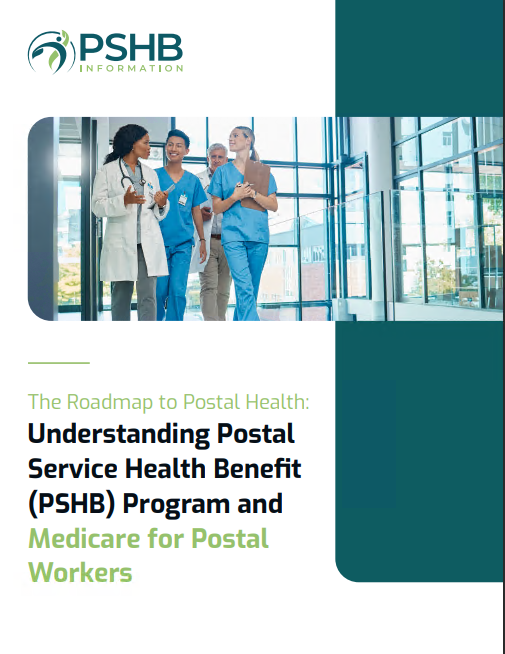Key Takeaways
-
Medicare Part D and Postal Service Health Benefits (PSHB) plans work together to ensure comprehensive prescription drug coverage for eligible beneficiaries.
-
Understanding how these programs integrate can help you make the most of your benefits while minimizing out-of-pocket expenses.
The Role of Medicare Part D in Prescription Drug Coverage
Prescription medications can be one of the largest healthcare expenses for retirees and annuitants. That’s where Medicare Part D, Medicare’s prescription drug coverage, steps in. This program is designed to help Medicare beneficiaries afford their medications and reduce the financial burden of high drug costs.
In 2025, Medicare Part D offers three distinct phases:
-
Deductible Phase: You pay out-of-pocket for prescriptions until you reach your deductible limit, which is capped at $590 for the year.
-
Initial Coverage Phase: During this phase, you share the cost of medications through copayments or coinsurance. Once your total drug costs hit $4,660, you move to the next phase.
-
Catastrophic Coverage Phase: After reaching the $2,000 out-of-pocket cap, you enter this phase where Medicare covers 100% of your prescription drug costs for the remainder of the year.
These phases ensure that beneficiaries are not financially overwhelmed by prescription costs. With the recent elimination of the donut hole, or coverage gap, Medicare Part D is more predictable and easier to navigate.
How PSHB Plans Complement Medicare Part D
The Postal Service Health Benefits (PSHB) program, introduced in 2025, provides comprehensive health coverage tailored specifically for postal workers, retirees, and their families. When you’re enrolled in both Medicare Part D and a PSHB plan, you’ll find that they work together seamlessly to lower your out-of-pocket costs for prescription drugs.
Here’s how these programs align:
-
Integrated Coverage: Many PSHB plans include a Medicare Part D Employer Group Waiver Plan (EGWP), which is automatically provided when you enroll in Medicare Part D. This integration ensures your prescription drug costs are managed effectively.
-
Cost Reductions: PSHB plans often offer reduced or waived deductibles, lower copayments, and coinsurance for beneficiaries who also have Medicare Part D.
-
Pharmacy Networks: Both programs typically use extensive networks of preferred pharmacies, giving you the flexibility to fill prescriptions at convenient locations.
By combining the strengths of Medicare Part D and your PSHB plan, you’re positioned to receive robust prescription drug coverage without unnecessary complexity.
Eligibility and Enrollment Made Easy
To maximize your benefits, it’s essential to understand eligibility and enrollment requirements for Medicare Part D and PSHB plans.
Medicare Part D Eligibility
You are eligible for Medicare Part D if:
-
You’re enrolled in Medicare Part A, Part B, or both.
-
You reside in the U.S. and are not incarcerated.
Enrollment in Medicare Part D typically occurs during your Initial Enrollment Period (IEP), which spans seven months around your 65th birthday. If you miss your IEP, you can enroll during the Annual Enrollment Period from October 15 to December 7 each year.
PSHB Enrollment
For the PSHB program, enrollment is automatic for eligible postal employees and annuitants transitioning from the Federal Employees Health Benefits (FEHB) program. However, any changes to your plan must be made during the PSHB Open Season, which runs from November 11 to December 13 each year. Outside this window, modifications can only occur due to a Qualifying Life Event (QLE).
Coordinating Benefits to Minimize Costs
One of the significant advantages of having both Medicare Part D and a PSHB plan is the ability to coordinate benefits effectively. By understanding how the two programs work together, you can reduce your out-of-pocket expenses and gain peace of mind.
Waived Deductibles and Lower Copayments
Many PSHB plans waive or significantly reduce deductibles for prescription drugs if you’re enrolled in Medicare Part D. Additionally, copayments for generic and brand-name medications are often lower, making it more affordable to fill your prescriptions.
Catastrophic Coverage Protection
When you hit the $2,000 out-of-pocket maximum under Medicare Part D, your PSHB plan may step in to cover costs not included in Medicare’s catastrophic coverage, such as non-formulary drugs or additional pharmacy charges. This coordination ensures you’re not left with unexpected bills.
Tips for Making the Most of Your Coverage
Navigating the intricacies of Medicare Part D and PSHB plans can seem daunting, but with the right approach, you can maximize your benefits. Here are some tips to help you:
1. Review Your Plan Options Annually
Both Medicare Part D and PSHB plans update their formularies, premiums, and benefits each year. By reviewing your Annual Notice of Change (ANOC) during Open Season, you can ensure your plan still meets your healthcare needs.
2. Use Preferred Pharmacies
Both Medicare Part D and PSHB plans often have networks of preferred pharmacies that offer lower costs for prescription drugs. Filling your prescriptions at these locations can save you a significant amount of money.
3. Opt for Generic Medications When Possible
Generic medications typically cost less than their brand-name counterparts. Ask your healthcare provider if generics are available for your prescriptions, as they can reduce your out-of-pocket expenses.
4. Keep Track of Your Costs
Monitoring your out-of-pocket spending throughout the year can help you plan for when you’ll reach Medicare Part D’s catastrophic coverage phase. Staying informed ensures you’re prepared for any cost changes.
Key Deadlines to Keep in Mind
Staying on top of deadlines is crucial for seamless healthcare coverage. Here are the key dates to remember:
-
October 15 to December 7: Medicare Part D Annual Enrollment Period. Use this time to enroll in, drop, or switch your Part D plan.
-
November 11 to December 13: PSHB Open Season. Review and update your PSHB plan during this window.
-
January 1: Start of coverage for any changes made during the enrollment period.
Mark these dates on your calendar to avoid missing critical enrollment opportunities.
Understanding Costs and Coverage for 2025
While private plan prices vary and cannot be discussed here, general costs under Medicare Part D and PSHB plans can provide a clearer picture of what to expect:
-
Medicare Part D Costs:
-
Annual Deductible: Up to $590.
-
Out-of-Pocket Cap: $2,000 for prescription drugs.
-
-
PSHB Plan Costs:
-
Deductibles and copayments vary based on the specific plan and whether services are in-network or out-of-network.
-
Government contributions typically cover about 70% of the total premium, reducing your financial burden.
-
These details can help you estimate your healthcare expenses and plan your budget accordingly.
Why Integration Matters
The integration of Medicare Part D with PSHB plans ensures that postal workers, retirees, and their families receive the comprehensive prescription drug coverage they deserve. By working together, these programs reduce costs, simplify access to medications, and provide a safety net for high healthcare expenses.
Maximize Your Benefits with Strategic Planning
Understanding how Medicare Part D and PSHB plans align is essential to getting the most out of your healthcare benefits. Review your coverage annually, take advantage of preferred pharmacies, and stay informed about program changes to keep your costs manageable. With these tools at your disposal, you’re better equipped to meet your prescription drug needs.









